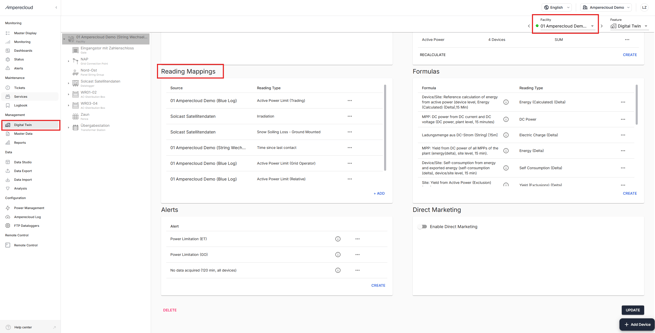The “Peak billing yield losses (active power limitation)” report breaks down whether a system has been regulated. In contrast to the (relative) version, the (DVM and NSM) version can distinguish who has controlled. Whether this is possible depends on whether the data logger/park controller sends the control signals in a differentiated manner.
Prerequisites for report generation
Irradiation data at facility level
Irradiation at facility level is a prerequisite.
There are two options for this:
- If several sensors are available: Calculations of the average irradiation value.
- If only one sensor is available: Direct reading mapping.
Note: If no irradiation sensors are available, contact your Customer Success Manager to acquire satellite data if necessary..
Calculation
During the calculation, the average irradiation from several sensors is calculated.
- Navigate within the digital twin to your facility and then to Calculations.

- Click on Create.
- Enter irradiation under Measured values.
- Click on + Add and add the corresponding sensors.

- Set the calculation to AVERAGE.
- Then click on save.

Direct reading mapping.
If only one sensor is available, it can be directly mapped as the measurement value.
The following three signals can be captured:
- Active power limitation (Trading) (active power limitation through direct marketing)
- Active power limitation (Grit Operator) (active power limitation through grid security management)
- Active power limitation (Relative) (result from DVM and NSM - always the lower value)
- If only an unknown value is sent, this (relative) value must be assigned.
- If DVM and NSM are available, but no relative value, this must be activated in formulas. Jump to details

- Navigate within the digital twin to your facility and then to the Reading Mappings.

- The measured value irradiation must be mapped

- Click on “Add”.
- Select the facility's data logger as the source.

- Search for the corresponding reading under Data stream:
In this example, it would be "POWER_PLANT_CONTROLLER/PPC_P_SET_GRITOP_REL" for the grid operator. - Unter Reading Type select the corresponding reading:
In this case, active power limitation (grid operator) - Check whether a Correction (Divisor) is required:
- If values between 0-100 are sent, they must be divided by 100, as the system expects values between 0-1.
- Click on Save.

- If DVM and NSM are available, but no relative value, it must be activated in formulas.
Activating the formula for calculating the relative value
- Navigate to Formulas.

- Click on “Create”.
- Select the formula “Site: Calculation of a Continuous Signal for Active Power Limitation (Grid Operator) [5m]”.
- Save the formula.

Checking the correct setup
- Navigate to Monitoring.
- Select the facility.
- To check whether the following values exist, open a new column for:
- (Current) Active power limitation grid operator
- (Current) Active power limitation Relative
- Current) Irradiation

Click on the ![]() symbol to show and hide graphs.
symbol to show and hide graphs.
- Active power limitation Relative
- Irradiation data
Note: If the relative value is calculated using a formula, it may take a few minutes for the values to be visible.
If irradiation has been added by calculation, it may take a few minutes before the values are visible.
- You can now use the data to see when the facility is regulated.
- You can now use the Yield losses report.
Creation of the “Peak billing for loss of income” report
- Navigate to the “Reports” tab.
- Select the report “Peak billing revenue shortfalls (relative)” or - if differentiated - “DVM and NSM”.

- Select the corresponding attachment and the desired time period.
- Enter the recipient (user/email address).
Note: As the report is output as an Excel file, saving as a PDF is not recommended.
- If irradiation was added by calculation, it is only displayed from the time of activation.
- If a retroactive calculation is required, this must be recalculated under Calculations.

Additional information:
- The report was implemented in accordance with the guidelines for peak billing.
- If no reference day is found in the last 30 days on which no regulation has taken place, a default value of 0.9 is used as the performance ratio.
Need More Help?
If you encountered any difficulties or need further assistance, here are some steps you can take:
Contact Support:
- Email: Reach out to our support team by emailing us at support@amperecloud.com. Provide as much detail as possible about the issue you're facing.
- Fill out a form: Complete our online support form. Please include all relevant information about your request, and our team will get back to you as soon as possible.
Share Your Feedback
If this article didn’t meet your needs or if you have suggestions on how we can improve, please let us know by submitting feedback. Your input helps us enhance our resources and support.
